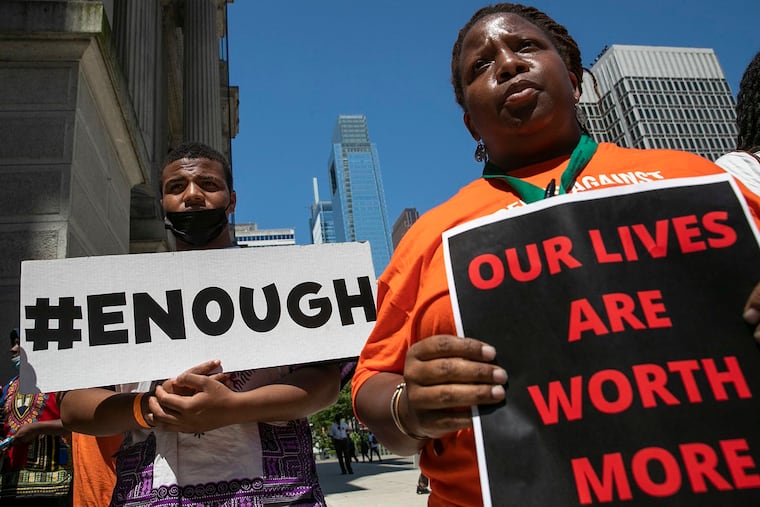We can’t fix violence in schools without large-scale prevention programs for students
In almost a decade of teaching, I've never seen a major violence prevention program at the high school level. I've seen healthy food magic acts, but it's hard to care about apples when kids are dying.

On the eve of my initiation to urban education in Philadelphia, I spent the evening cleaning blood from my husband’s hands.
An hour earlier, a young man had stumbled down our block after being shot in the stomach. Nobody knew how quickly an ambulance could get there, so my husband and a few of our neighbors helped carry the teenager to a police patrol car, and he was taken to a hospital.
Unlike so many young gunshot victims in our city, the teenager lived.
That night has been a metaphor for my teaching career in the city — brief moments of calm punctuated by sudden, spontaneous acts of violence. Since that evening in 2014, there have been thousands of young people who have been shot to death in Philadelphia.
And I’ve often wondered: If my students are seeing the same kind of bloodshed I have — or if they’ve witnessed worse — what are we doing to help them cope?
From my time in the classroom, it’s clear to me that there is a need for a data-informed violence prevention program in all district schools that reaches all students during the regular school day.
I will soon celebrate nine years as a teacher in the School District of Philadelphia. That is nine years of being surrounded by memories of those who have been slain. Hundreds of balloons released at memorials. Countless tears shed by school staff. A daily stream of brothers, friends, and cousins killed in the wake of gunfire; summer arrests and summer losses.
I recently had a student express that he had seen so many gunshot victims that he was “immune to it.” In an op-ed published during the last school year, Superintendent Tony B. Watlington Sr. remarked, “And when I talk to our children, I hear how many of them are scared because of the unrelenting gun violence devastating neighborhoods across Philadelphia. Accordingly, safety must be our top priority.”
For the last decade, I’ve been unable to watch the local news, afraid that I would recognize a face — a beloved student, the humorous class clown — afraid that those rumors about the brilliant freshman who was shot in the face were true. I am not the only one. These are not statistics — these are lives endued with potential that have been tragically cut short.
Despite these staggering losses, I have never seen a large-scale gun and violence prevention program at the high school level. Oddly enough, I have seen opioid-use presentations. I have endured endless STD testing days (and the predictable jokes among adolescents about urine). I have seen years of healthy food magic acts, underwritten by the department of health. But it is hard to care about disappearing apples when students are dying daily on the sidewalk.
In Pennsylvania, agencies receive funding for outreach by applying for grants. According to the Special Council on Gun Violence, violence prevention is conducted through community-based organizations. Those efforts can take the form of youth mentorship, community partnerships, or direct outreach programming. But oftentimes, this funding does not reach many of the most vulnerable young people in the city for a number of reasons.
Far too many students are not plugged into the organizations that provide mentorship and prevention. In my experience, many students are responsible for taking care of younger siblings; others may be one of the main breadwinners for their families. Others are simply not connected because of the breakdown of social engagement.
This is not to detract from the amazing coaches who steer youth, programs like the Police Athletic League, nonprofit community youth development, and after-school programming. These programs certainly have a place and an impact. Nevertheless, they only reach a fraction of the youth population.
Other targeted and location-based programs like Philadelphia CeaseFire only reach a select number of young people because of eligibility requirements, including incarceration, past conviction, and being a victim in a recent shooting. There is a need for more programs that require fewer strings.
Preventative school programming can reach all young people when they are in the classroom. Let me be clear, I am not advocating for a model that places the onus on teachers who do not have the behavioral health background nor the experience needed to deal with such complex issues. Enough is on their plates already.
I am also not absolving lawmakers of their responsibility to enact commonsense gun legislation. Nor am I diminishing the work of nonprofits like the Anti-Violence Partnership, which are often on the front lines after a calamity. What I am advocating is an attempt to reach all students.
There is potential in efforts like those run by Mastery Charter Schools, which recently teamed up with Philadelphia CeaseFire to provide programming to students. The program brings the nonprofit’s mission into school walls as a part of its trauma-informed orientation.
We must treat gun violence as the crisis that it is. While we have deployed hundreds of COVID-19 preventive measures and distributed thousands of masks, we have not done nearly enough to prevent the epidemic of gun violence among our youth.
Lydia Kulina-Washburn is a high school English language arts teacher in the School District of Philadelphia. @LydiaKulina